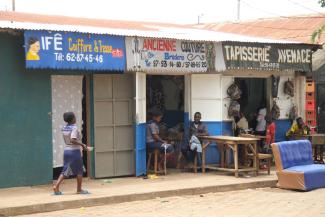PEGNet conference
Education for social advancement

As a driver of growth, good education has long been a focus of development policy. The Millennium Development Goals (MDGs), which were adopted by the UN in 2000, prioritised increasing enrolment rates. By contrast, the follow-up agenda of the Sustainable Development Goals (SDGs), emphasises the quality of education. Where gender disparities are large, moreover, better opportunities must be provided to girls. Gender equity was also part of the MDG agenda.
Another decisive issue is whether an education system facilitates upward mobility or cements the status quo. If all children, regardless of their family background, get the same opportunities, social mobility is strong. Whether children move on from primary school to secondary school, however, does not only depend on their school performance. What matters too is school fees, the distance from a child’s home to the next secondary school and the family’s general economic situation.
Fabian Könings from the University of Jena and Jakob Schwab from the German Development Institute (DIE) have identified other key factors. They examined social mobility over generations in India, Peru, Ethiopia and Vietnam. The researchers considered five issues with a bearing on children’s success in school:
- the time they spend doing housework and child labour,
- their health,
- the time it takes them to get to school,
- how many siblings they have and
- their cognitive abilities.
All of these factors are related to poverty. The study shows that children from poor households have a 20 % lower chance of graduating from secondary school than children from middle-class households. The main reason was poor children’s lower cognitive abilities, which accounted for 15 % of the disparity between their grades and those of their middle-class peers. The ratio for child labour was 12 %. For a large number of siblings, it was eight percent.
“Girls are a bit less upwardly mobile than boys,” Könings said at this year’s conference of the Poverty Reduction, Equity and Growth Network (PEGNet), which took place in Cotonou, Benin, in October. The authors also found that the number of children in the household only had an impact on girls. The revised version of the unpublished study will consider child marriage and children’s own educational aspirations.
Personal aspirations
Leonard Wantchekon, a professor at Princeton University in the US and the director of the African School of Economics in Benin, points out that other factors influence children’s social mobility apart from the economic situation of their parents. He did research on three generations in Benin, beginning with the first generation to ever attend primary school. He found examples of upward mobility both in the second and in the third generation.
There were also cases of downward mobility. Typical reasons were that people avoided financial and social risks and therefore failed to grasp educational and employment opportunities. Other reasons that explained lower incomes in the third generation included mental health problems, a negative outlook on life and little self-reliance.
“Aspirations and effort play a big role,” Wantchekon emphasises. He himself is a perfect example of successful social mobility: his grandfather belonged to the first generation in his village to attend school, his uncle was a railroad manager, and he himself became a professor of economics at an elite American university. Wantchekon argues that the education of grandparents leads to grandchildren setting themselves ambitious goals and accepting risks.
61 % without formal education
School-enrolment rates in Benin have increased dramatically in recent years (see article by Janina Meister in D+C/E+Z e-Paper 2018/07). Most children, however, do not continue after the mandatory six years of primary school. Only 16 % of Beninese boys and girls attend secondary school and only three percent pursue post-secondary education. Sixty-one percent of people have no formal education at all.
Andreas König, the country director for GIZ in Benin, points out that, as elsewhere in sub-Saharan Africa, the educational system of this small Francophone country is hardly linked to what kind of skills and knowledge the labour market demands. Only three percent of the secondary schools are vocational schools. According to König, many graduates end up working in the informal sector. In his view, the greatest challenges are the poor quality of schools and the inadequate funding for vocational education. He believes that Benin will have a hard time of living up to the UN principle of not leaving anyone behind.
Women and girls face particular obstacles. There are large gender disparities in education across most of sub-Saharan Africa. In response, the government of Benin has been emphasising the education of girls since the 1990s. It has undertaken measures like awareness raising, gender-equity training for teachers and special competitions and prizes for female pupils.
In 2007, a programme was launched to exempt girls from paying tuition in junior high schools (seventh to tenth grade). Since 2010, it has been in force nationwide. Leonie Koumassa of the African School of Economics has studied its impact.
According to her, it has had many positive outcomes: significantly more girls are enrolled, the number of years that girls spend in school has increased and fewer of them dropped out. Moreover, girls are now setting themselves more ambitious career goals on average.
Koumassa was surprised by a side effect of supporting girls: “More boys went to school, too.” One reason may be that families had more money at their disposal after the girls’ tuition fees were waived. According to the researcher, the fees ranged from about € 14 to € 30 per year, depending on the region. Moreover, families also have to pay for stationary, text books et cetera. “For poor families, this is a lot of money, especially if they have many children.”
At the same time, the policy has some weaknesses. The government did compensate schools for the funding gap caused by girls no longer paying tuition fees. While it paid reimbursements, though, it only did so at the end of the school year and not in full. Financial bottlenecks were the result. More students, moreover, meant larger class sizes. “It’s not uncommon to have 50 children in one class,” Koumassa says. According to her, additional teachers were not hired. Classroom space is insufficient as well. Overall, the quality of instruction has declined, and so has pupils’ performance. Given Benin’s fast population growth, problems are likely to intensify.
Koumassa wants the government to improve its generally sensible promotion of girls by investing in infrastructure and teacher training. She emphasises that greater gender equality in education will have a bearing on other areas, including children’s health and nutrition. Just like better education, that would also contribute to the country’s sustainable development.
Katja Dombrowski is a member of D+C/E+Z’s editorial team. The studies discussed in her essay are still unpublished, but the results were presented at the Poverty Reduction, Equity and Growth Network (PEGNet) conference on “Improving the quality of education and learning outcomes in developing countries” in Cotonou, Benin, in October. It was organised in cooperation with the African School of Economics (ASE).
euz.editor@fazit-communication.de








